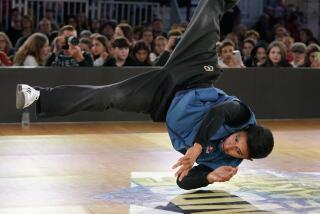This Year’s Newfangled Sport: Snakeboarding
- Share via
It seems that all the great teen crazes have at least some association with warm summer days. That goes for Hula Hoops and Frisbees to surfboards, skateboards and in-line skates. Now, the makers of an odd-looking little conveyance called the Snakeboard hope they have the latest hot-weather hit.
The Snakeboard looks something like a skateboard--but not quite. Although skateboards have gone through a lot of refinements since the days of plywood boards and steel wheels, the basic concept has remained pretty much the same: one board with four fixed wheels, propelled either by gravity or by being pushed along by one foot.
Snakeboards, on the other hand, employ an entirely different principle. For one thing, the rider’s feet never touch the ground. The Snakeboard has two foot plates that pivot independently, but they are connected by a center crossbar.
The rider twists his feet, alternating between heels-together and toes-together, sending the Snakeboard forward in a slightly serpentine path (hence the name). There’s a lot of body English involved too: flexing the hips and moving the shoulders helps control steering and speed. Makers of the device, San Diego-based Snakeboard USA, claim speeds can top 20 m.p.h.
One recent afternoon at the Paradise Beach Co. next to the Huntington Beach Pier, manager Tom Koshi drew puzzled comments and stares from customers as he snaked his way elegantly around tables and displays in the crowded shop.
“It’s an attention-grabber, that’s for sure,” Koshi said. Earlier in the week, he added, demonstration riders from Snakeboard USA visited the shop, drawing crowds as they wound along near the foot of the pier.
The shop, which sells the boards for $139, has carried them for about six weeks, said owner Glenn Koshi. It’s taken about that long for store employees to master the devices, Tom Koshi added.
“They’re kind of hard to learn, but that’s half the fun,” he said. “We’ve just been playing with it.”
The Snakeboard was designed about four years ago in South Africa by a young inventor named James Fisher, now 24 years old. He was trying to come up with a steerable skateboard, and his first prototype involved a pair of roller skates connected by a piece of plumbing pipe.
After the board was perfected, Fisher began marketing it in South Africa. Last year, investors bought the North American rights and selected a San Diego marketer of in-line skates as distributor, the company now called Snakeboard USA.
“It’s a whole different type of movement,” said company sales manager Bill Reilly. The riding technique, he said, has more in common with snow boarding than with traditional skateboarding: “You can’t just jump on it and ride like you can a skateboard.”
Once it is mastered, though, Reilly said the Snakeboard can do many of the same ramp jumps and other tricks as a skateboard. Although the Snakeboard doesn’t have a kick-tail, as a skateboard does, it can be outfitted with straps to hold the feet in place.
Since getting started in December of last year, the company has sold about 3,000 of the boards, primarily in California and Florida, and it is preparing to market two new models.
“It’s selling pretty well,” Reilly said. “I do see it catching on,” though probably not to the degree in-line skating has, primarily because everyone has to have their own pair of skates, while a family can make do with one Snakeboard. Also, the Snakeboard market is somewhat narrower: The target age for the product is 7 through the teen years.
The specs, for skateboard junkies: foot plates and crossbars are made from a nylon fiber material, wheels are 65mm polyurethane with a nylon hub. The wheel bearings are bigger than the standard for skateboard wheels, because of the longer axle.
As with skateboarding and skating, riders are urged to wear wrist guards, knee pads, elbow pads and helmet.
Bike Notes: Bikefest ’92 is a pair of events sponsored by the Orange County Chapter of the National Multiple Sclerosis Society. The first is the Tour of the Bases on July 25, with two routes available. The 25-mile option will take riders through the Tustin Marine Corps Air Station; the 50-mile route will include the El Toro Marine Air Corps Station.
The second event is the Midnight Ramble on Aug. 8, a 10-mile ride through Tustin Ranch. Registration fees are $15 for the Tour of the Bases, $35 for the Midnight Ramble. Riders are encouraged, but not required, to raise pledges for the rides. Information: (714) 7521680.
Finally, a belated note on last month’s merger between the county’s largest recreational cycling club, the Orange County Wheelmen, and the 31-year-old Paramount Cycling Club, a local race team. The race team will take on the name OCW-Paramount Racing for the 1993 season.
The combined organizations, which will now be able to offer race-level training, have a membership base of more than 1,000.


